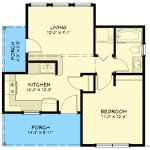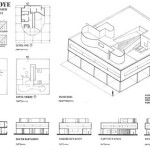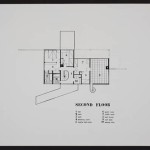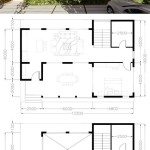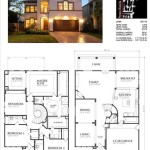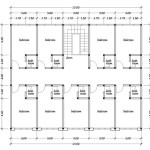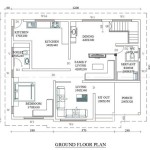What Is A 3D House Plan?
A 3D house plan is a digital representation of a residential building, rendered in three dimensions. Unlike traditional 2D blueprints, which provide flat, orthogonal views of a structure, a 3D house plan offers a comprehensive and visually realistic depiction of the entire building, both interior and exterior. This type of plan allows viewers to understand the spatial relationships, design elements, and overall aesthetic of a home before it is physically constructed.
The creation of a 3D house plan typically involves specialized software, often referred to as architectural rendering or building information modeling (BIM) programs. These tools allow architects, designers, and homeowners to visualize the completed structure from various angles, experiment with different design options, and identify potential issues before construction begins. The level of detail in a 3D house plan can range from basic massing models to highly photorealistic renderings that include textures, lighting, and even landscaping.
The use of 3D house plans has become increasingly prevalent in the architecture and construction industries due to the numerous advantages it offers over traditional 2D plans. These benefits include improved communication, enhanced visualization, and reduced errors during the design and construction process. Furthermore, 3D house plans can be easily shared with clients, contractors, and other stakeholders, facilitating collaboration and ensuring that everyone is on the same page throughout the project.
Understanding the Core Components of a 3D House Plan
A typical 3D house plan incorporates several key components that contribute to its overall accuracy and visual appeal. These components are meticulously crafted to represent the various elements of the house, from the foundation to the roof, and everything in between.
The architectural model forms the foundation of the 3D house plan. This model accurately defines the dimensions, shape, and spatial relationships of the building’s structural elements, including walls, floors, ceilings, doors, and windows. The model is built using precise measurements and adheres to building codes and regulations. Accuracy is paramount at this stage, as any errors in the model can propagate throughout the entire design process.
Next comes the application of textures and materials. These elements add visual realism to the 3D house plan by simulating the appearance and properties of different building materials. This includes brick, wood, stone, glass, and various types of flooring. The selection of appropriate textures and materials is crucial for conveying the intended aesthetic of the house and allowing viewers to accurately visualize the finished product. Advanced rendering software can even simulate the effects of aging and weathering on these materials.
Lighting and shadows are also crucial. Realistic lighting enhances the depth and dimension of the 3D house plan, creating a more immersive and believable experience. This includes simulating natural light from the sun, as well as artificial lighting from lamps, fixtures, and appliances. The correct placement and intensity of light sources can dramatically alter the perceived mood and atmosphere of a space. Shadows play an equally important role, defining the shapes and contours of objects and adding a sense of realism to the rendering.
Finally, landscaping and environment are often included to provide context and enhance the overall presentation of the 3D house plan. This can include trees, shrubs, grass, walkways, driveways, and even neighboring buildings. The addition of landscaping helps to integrate the house into its surroundings and create a more appealing and realistic visual representation. The environment can also include elements such as sky, clouds, and reflections in windows, further enhancing the realism of the rendering.
The Benefits of Using 3D House Plans
The advantages of using 3D house plans extend beyond just aesthetics. They offer significant practical benefits that streamline the design and construction process, reduce costs, and improve communication among all parties involved.
Improved Visualization is a key benefit. 3D house plans provide a clear and intuitive understanding of the design, allowing clients to visualize the completed house from various perspectives and assess the overall aesthetic. This is particularly helpful for clients who are not familiar with reading traditional 2D blueprints. The ability to see the house in 3D helps to bridge the gap between abstract plans and concrete reality, enabling clients to make informed decisions about the design.
Another significant advantage is enhanced communication. 3D house plans facilitate communication between architects, designers, contractors, and clients. By providing a common visual reference point, 3D plans help to avoid misunderstandings and ensure that everyone is on the same page. This is especially important when dealing with complex or unconventional designs. The ability to easily share and collaborate on 3D models online further enhances communication and streamlines the design process.
Early identification of design flaws is also a huge benefit. 3D house plans allow for the early identification of potential design flaws and spatial conflicts. By visualizing the house in three dimensions, architects and designers can identify issues that might not be apparent in 2D plans, such as awkward room layouts, insufficient headroom, or conflicts between structural elements and mechanical systems. Addressing these issues early in the design process can save time and money by preventing costly rework during construction.
Furthermore, facilitation of better decision-making is apparent. The visual clarity of 3D house plans allows clients to make more informed decisions about design options and material selections. By experimenting with different colors, textures, and lighting schemes in a virtual environment, clients can see how these elements will look in the finished house before committing to them. This can help to avoid costly mistakes and ensure that the final design meets their expectations.
Accurate cost estimation is also possible due to the clarity of the 3D house plan. 3D house plans can be used to generate accurate cost estimates for materials and labor. By accurately quantifying the amount of materials needed for each component of the house, contractors can provide more precise bids and avoid unexpected cost overruns. The visual clarity of the 3D plan also helps to identify potential cost-saving opportunities, such as optimizing the layout to reduce material waste.
Applications of 3D House Plans in Different Fields
3D house plans have a wide range of applications beyond the traditional architectural design process. They are used in various fields, including real estate, marketing, and construction management.
In real estate, 3D house plans are used to market properties to potential buyers. High-quality renderings and virtual tours can showcase the features and benefits of a house more effectively than traditional photographs. This is particularly useful for pre-construction sales, where buyers can visualize the finished house before it is built. 3D house plans can also be used to create interactive presentations that allow buyers to explore the house at their own pace and customize the design to their preferences.
In marketing, 3D house plans are used to create visually compelling brochures, websites, and advertisements. The realistic renderings and animations can capture the attention of potential customers and create a lasting impression. 3D house plans can also be used to create virtual reality (VR) experiences that allow customers to immerse themselves in the design and explore the house as if they were physically present.
Construction management also benefits from 3D house plans. They are used to coordinate the work of different trades and ensure that the construction process runs smoothly. By visualizing the house in three dimensions, contractors can identify potential conflicts and resolve them before they cause delays or cost overruns. 3D house plans can also be used to track progress on the construction site and communicate updates to stakeholders.
Homeowners can also use 3D house plans for renovation and remodeling projects. Visualizing the proposed changes in 3D can help them to make informed decisions about the design and ensure that the finished project meets their expectations. 3D house plans can also be used to obtain permits and approvals from local authorities.
Ultimately, 3D house plans have revolutionized the way houses are designed, built, and marketed. Their ability to provide a clear and intuitive understanding of the design has made them an indispensable tool for architects, designers, contractors, real estate agents, and homeowners alike.

How Much Do 3d House Plans Cost Faqs Answered Cedreo

How Do You Make A 3d Floor Plan

How Much Do 3d House Plans Cost Faqs Answered Cedreo

Create 3d Floor Plans With Roomsketcher

What Is A 3d Floor Plan Rendering Cedreo

What Is 3d Floor Plan How To Make It Benefits Cost

Benefits Of Using 3d House Floor Plan Design

Create 3d Floor Plans With Roomsketcher

3d Floor Plan Wikipedia

Everything You Need To Know About 3d Floor Plans

